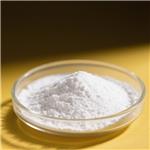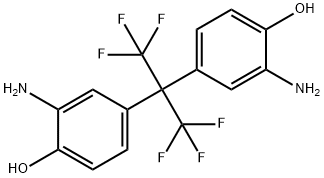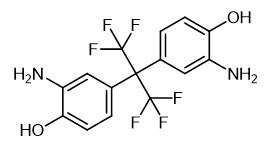2,2-Bis(3-amino-4-hydroxyphenyl)hexafluoropropane: For Functional Polyimide Synthesis and Material Modification
2,2-Bis(3-amino-4-hydroxyphenyl)hexafluoropropane (6FAP), has two aminophenols bridged by a hexafluoropropane. Like other diamine compounds, 2,2-bis(3-amino-4-hydroxyphenyl)hexafluoropropane reacts with dicarboxylic anhydride to form polyimide membranes showing gas selectivity for hydrogen with ultrafine microporosity. Those fluorinated membranes have high proton conductivity along with good chemical and thermal stability, making it optimal to be used in fuel cell systems. The polyimides synthesized from 6FAP exhibit photosensitivity as second order nonlinear optical properties. After the formation of polyimides, there are unreacted hydroxy groups on the polymer backbone. Therefore, graft polyimides can be obtained through further Mitsunobu reaction or condensation reactions.In the molecular structure of 2,2-Bis(3-amino-4-hydroxyphenyl)hexafluoropropane, the hydroxy and amine groups are at ortho-position to each other, so it is perfect for synthesizing polybenzoxazoles for semiconductor manufacturing applications.

Syntheses of Colorless and Transparent Polyimide Membranes for Microfiltration
Conventional methods for treating wastewater and contaminated solvents include the use of filters, biological drainage, ozonation, coagulation flocculation, powdered activated carbon adsorption, electrochemical processes, and photocatalysts. However, it is difficult to completely remove impurities using these methods. In addition, most of the abovementioned methods result in the generation of new impurities due to the addition of chemicals during the purification process. Herein, we synthesized two poly(amic acid)s (PAAs) by reacting 4,4’-(hexafluoroisopropylidene) diphthalic anhydride (6FDA) as a dianhydride with 2,2-bis(3-aminophenyl) hexafluoropropane and 2,2-bis(3-amino-4-hydroxyphenyl)hexafluoropropane as diamines. The blend materials were fabricated by blending PVA in various amounts, ranging from 0 to 5 wt% with the synthesized PAAs. The thermal properties, morphologies, and optical transparencies of the two types of CPI films, synthesized using two different monomers (6FAm and 6FAm-OH), were investigated and compared. Colorless and transparent porous PI membranes were prepared using a CPI/PVA blend. To synthesize CPI, 6FDA was used as a dianhydride and 6FAm and 6FAm-OH were used as diamines. To prepare porous membranes, water-soluble PVA was used in the CPI blend. As 2,2-Bis(3-amino-4-hydroxyphenyl)hexafluoropropane contains -OH groups in the main chain, hydrogen bonding is possible not only in the PI chain itself but also between PI and PVA present in the blend.[1]
In this study, the CPI membranes synthesized using 6FAm and 2,2-Bis(3-amino-4-hydroxyphenyl)hexafluoropropane were compared with each other at different PVA concentrations. As a very thin CPI membrane film (18–21 μm) was prepared, a pure CPI membrane could be prepared by almost completely removing the PVA component in an aqueous solution. The Tg of CPI with 2,2-Bis(3-amino-4-hydroxyphenyl)hexafluoropropane was higher than that of CPI with 6FAm PI due to hydrogen bonding between the polymer chains; in the latter films, the pore diameter was small due to the tighter structure. In contrast, the TDi and wtR600 values of CPI with 6FAm-OH were lower than those of CPI with 6FAm due to the low thermal stability of the -OH group. Regardless of the amount of PVA, the optical transparency of all the obtained CPI membranes was excellent. In conclusion, these CPI membrane films are expected to be useful as high functional polymeric materials as well as in the field of filtration, due to their superior thermal property and optical transparency as compared to that of general purpose engineering polymers.
Surface modification of PBO fibers with 2,2-Bis (3-amino-4-hydroxyphenyl) hexafluoropropane
Poly-p-phenylene benzobisoxazole (PBO) fiber is one of the most potential members of the family of heterocyclic aromatic polyamides, which is widely used in missile and bullet protection equipment, bulletproof vests, bulletproof helmets, and aerospace because of its low density, high strength, modulus, heat resistance, and flame resistance. It is one of the most important reinforcements for advanced composites. However, due to the smooth surface and inert chemical structure of PBO fibers, the interfacial strength between the fiber and matrix is poor, which seriously restricts the performance of composites. 2,2-Bis(3-amino-4-hydroxyphenyl)hexafluoropropane (BisAPAF) was used to modify the surface of PBO fibers as it has high solubility in scCO2, and then by changing the pressure to control the amounts of polar groups on the surface to improve the interfacial properties. After the treatment, the fibers were washed with acetone for three times to remove the unreacted 2,2-Bis(3-amino-4-hydroxyphenyl)hexafluoropropane on the fiber surface, and dried in an oven at 100 °C for 8 h. Control fiber was denoted as PBO-untreated, and samples modified in scCO2 were denoted as PBO-BisAPAF-10MPa, PBO-BisAPAF-12MPa, PBO-BisAPAF-14MPa, and PBO-BisAPF-16MPa, respectively.[2]
PBO fibers were treated by 2,2-Bis(3-amino-4-hydroxyphenyl)hexafluoropropane in scCO2 directly at different pressures. The pressure can exert significant effects on surface chemical and roughness of PBO fibers. BisAPAF can be dissolved in the scCO2 and coated on the surface of PBO fibers. Due to the reaction of BisAPAF and coating on the surface of the PBO fibers, introducing groups of –NH2, –OH, and –CF on the fiber surface, the roughness and wettability were improved obviously. The enhanced mechanical interlocking and chemical bonding between PBO fiber and epoxy matrix causes the IFSS increased from 8.2 MPa to 31.4 MPa with an improvement of 282.9%. The above results showed that 2,2-Bis(3-amino-4-hydroxyphenyl)hexafluoropropane treatment in scCO2 for PBO fibers can enhance the interfacial adhesion of the PBO fiber and epoxy.
References
[1]Kim, Jong Won, and Jin-Hae Chang. “Syntheses of Colorless and Transparent Polyimide Membranes for Microfiltration.” Polymers vol. 12,7 1610. 20 Jul. 2020, doi:10.3390/polym12071610
[2]Zeng, J., Kong, H., Du, X., Xu, Q., Jiang, F., Li, B., & Yu, M. (2021). Surface modification of PBO fibers with 2,2-Bis (3-amino-4-hydroxyphenyl) hexafluoropropane in supercritical carbon dioxide for enhancing interfacial strength. *Materials Today Chemistry*, 20, 100426.
Related articles And Qustion
See also
Lastest Price from 2,2-Bis(3-amino-4-hydroxyphenyl)hexafluoropropane manufacturers

US $0.00-0.00/kg2025-10-27
- CAS:
- 83558-87-6
- Min. Order:
- 1kg
- Purity:
- ≥99.9%
- Supply Ability:
- 50MT

US $25.00/ASSAYS2025-06-27
- CAS:
- 83558-87-6
- Min. Order:
- 100ASSAYS
- Purity:
- 99.5%
- Supply Ability:
- 100 mt



